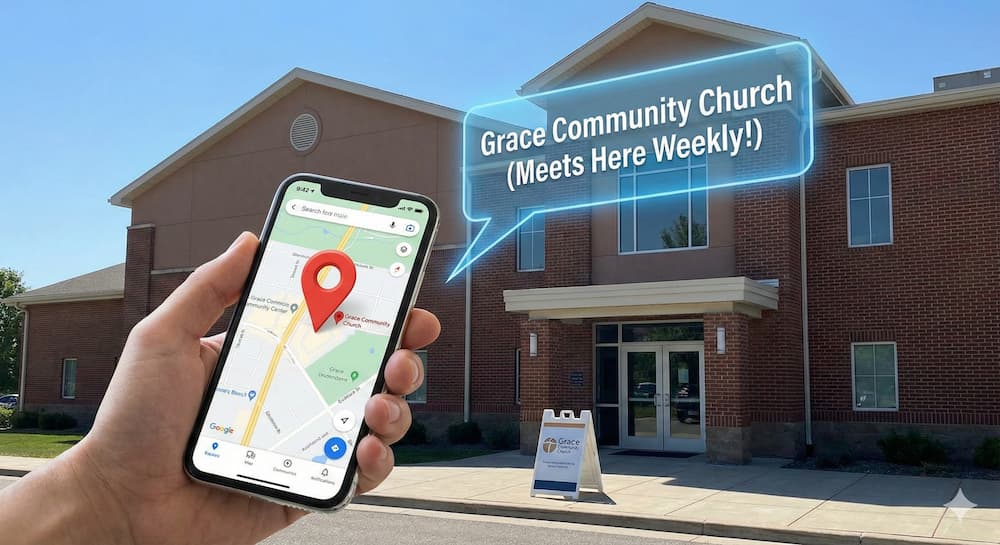Make Your Kids Ministry Safer
Keeping kids safe at church requires addressing potential blind spots and implementing effective safety measures.

It should go without saying that the safety of children is a top priority in church. But too often, we don’t have the measures in place to back this priority. Even well-intended volunteers can make exceptions to the rules, parents can forget protocol, and mistakes happen.
From implementing check-in systems to thorough background checks, our ministry leaders and volunteers must be well-equipped to keep children safe. This article will explore common blind spots in children’s ministry safety and offer practical solutions to make your ministry environment safer.
Common Blind Spots in Kids Ministry Safety
While many ministries strive to create a loving and nurturing environment, there are often overlooked areas that can create safety risks. Here are some of the most common blind spots:
No Check-In System
One of the biggest gaps in kids ministry safety is not having a formal check-in system. Without it, it’s difficult to keep track of who is entering the ministry area and picking up children. A proper check-in process is essential for maintaining control and ensuring the safety of every child.
The good news is that check-in can be easy and accessible. Most tools can be synced with a kiosk and name tag printer so that parents can check in children without ever having to interact with a volunteer.
Lax Pickups
Allowing children to leave with anyone who shows up without verifying identities poses a serious risk. Ministry leaders must implement strict policies for pick up, ensuring that only authorized individuals can take a child home. This is usually done best with name tags – at the time of check-in, name tags can be printed for both child and parent or authorized person, so that the matching name tag must be shown at pickup.
Minimal (or No) Volunteer Training
Volunteers who lack training may not be prepared to handle emergencies or recognize signs of potential issues with a child. Children's ministry volunteers should be trained on standard care for infants, toddlers, and babies, and volunteer leaders would benefit from CPR.
No Background Checks
Failing to conduct thorough background checks on volunteers or staff members creates a huge safety risk. Without this vital step, churches may inadvertently allow individuals with harmful intentions to have access to children, which could lead to sexual abuse or other forms of harm. Church leaders must ensure that every ministry volunteer undergoes a background check to protect the children and maintain a secure ministry.
Insufficient Info About Allergies or Special Needs
It’s crucial to collect detailed information about each child, including medical needs, allergies, and any other special requirements. Without proper notifications or name tags indicating these concerns, staff members might unknowingly put a child at risk.
Pillars of a Safe Children’s Ministry
To create a secure environment, there are essential pillars that should be present in any children’s ministry. These pillars ensure the safety of the children and foster an environment of trust and accountability.
Check-In System
A robust check-in system is vital for keeping kids safe. Systems like KidCheck not only log the child’s arrival but also track authorized pickups, helping your team keep control of who has access to the children. Digital check-ins also allow church leaders to monitor attendance and ensure accountability.
Name Tags and Lanyards
Name tags and lanyards help volunteers and ministry leaders easily identify both children and authorized adults. These tags should include important information such as allergies, special needs, and emergency contact details.
Database with Details and Contact Information
Maintaining a comprehensive database of children and their families is a non-negotiable aspect of ministry safety. This database should include contact information, authorized pickups, and any medical conditions. Accurate records help ministry leaders respond quickly in emergencies and provide peace of mind for families.
Volunteer Training
Every ministry volunteer must undergo mandatory training on safety protocols, including sexual abuse prevention and how to respond to emergencies such as active shooter situations. Partnering with organizations like MinistrySafe and ensuring regular safety drills are key to keeping your team prepared.
Background Checks
Every ministry volunteer should undergo thorough background checks. Background checks should be regularly updated, and volunteers should know that this is a standard practice to ensure the ongoing safety of the children. This is an essential step to protect children and maintain the integrity of your ministry. It shows that you are committed to creating a safe place for kids.
Partnering with the Safety Team
It’s important to ensure that your security team collaborates with your children’s ministry leaders. Together, they can conduct safety drills and review emergency plans regularly to ensure everyone knows their role in keeping children safe. The security team can also assist in monitoring access points, checking in with volunteers, and overseeing drop-off and pick-up procedures to prevent unauthorized individuals from entering the ministry area.
How to Train Your Children’s Ministry Volunteers on Safety
Training your volunteers is one of the most effective ways to ensure a secure environment for your kids ministry. Here are key strategies to equip your volunteers:
Establish Clear Guidelines
Begin by setting clear and thorough safety policies. These guidelines should cover the check-in process, pickup procedures, emergency protocols, and expectations for appropriate behavior within the ministry environment. Volunteers should also be trained in recognizing signs of child abuse or inappropriate behavior.
Hands-On Safety Drills
Conduct regular drills to prepare volunteers for emergencies, such as evacuations or lost children. Training for medical situations, such as when a child suffers from allergies, is also crucial. Hands-on training helps volunteers act swiftly and correctly when unexpected situations arise.
Provide First Aid and CPR Training
Equipping volunteers with first aid and CPR training provides another layer of safety in your ministry. If your children’s ministry leaders are confident in handling medical emergencies, it fosters an environment of security for both the children and parents.
Background Checks and Abuse Prevention Training
Every ministry volunteer should undergo thorough background checks and participate in abuse prevention training programs. This is an essential step to protect children and maintain the integrity of your ministry. It shows that you are committed to creating a safe place for kids.
Ongoing Training and Reviews
Training should not be a one-time event. Offer continuous reviews and safety workshops for your volunteers. Keep them updated on new security practices or software, such as KidCheck or MinistrySafe, to ensure they are always well-prepared.
A Safer Children’s Ministry & a Safer Church
Creating a safer children’s ministry takes careful planning, the right tools, and ongoing volunteer training. By addressing common blind spots, implementing the pillars of safety, and equipping your team through abuse prevention and emergency training, your ministry will provide a safe place where children can learn about Jesus and parents can have peace of mind. It’s our responsibility to protect the most vulnerable among us and ensure that our ministry environments reflect God’s love and care for His children.
Sign Up for Product Updates
It should go without saying that the safety of children is a top priority in church. But too often, we don’t have the measures in place to back this priority. Even well-intended volunteers can make exceptions to the rules, parents can forget protocol, and mistakes happen.
From implementing check-in systems to thorough background checks, our ministry leaders and volunteers must be well-equipped to keep children safe. This article will explore common blind spots in children’s ministry safety and offer practical solutions to make your ministry environment safer.
Common Blind Spots in Kids Ministry Safety
While many ministries strive to create a loving and nurturing environment, there are often overlooked areas that can create safety risks. Here are some of the most common blind spots:
No Check-In System
One of the biggest gaps in kids ministry safety is not having a formal check-in system. Without it, it’s difficult to keep track of who is entering the ministry area and picking up children. A proper check-in process is essential for maintaining control and ensuring the safety of every child.
The good news is that check-in can be easy and accessible. Most tools can be synced with a kiosk and name tag printer so that parents can check in children without ever having to interact with a volunteer.
Lax Pickups
Allowing children to leave with anyone who shows up without verifying identities poses a serious risk. Ministry leaders must implement strict policies for pick up, ensuring that only authorized individuals can take a child home. This is usually done best with name tags – at the time of check-in, name tags can be printed for both child and parent or authorized person, so that the matching name tag must be shown at pickup.
Minimal (or No) Volunteer Training
Volunteers who lack training may not be prepared to handle emergencies or recognize signs of potential issues with a child. Children's ministry volunteers should be trained on standard care for infants, toddlers, and babies, and volunteer leaders would benefit from CPR.
No Background Checks
Failing to conduct thorough background checks on volunteers or staff members creates a huge safety risk. Without this vital step, churches may inadvertently allow individuals with harmful intentions to have access to children, which could lead to sexual abuse or other forms of harm. Church leaders must ensure that every ministry volunteer undergoes a background check to protect the children and maintain a secure ministry.
Insufficient Info About Allergies or Special Needs
It’s crucial to collect detailed information about each child, including medical needs, allergies, and any other special requirements. Without proper notifications or name tags indicating these concerns, staff members might unknowingly put a child at risk.
Pillars of a Safe Children’s Ministry
To create a secure environment, there are essential pillars that should be present in any children’s ministry. These pillars ensure the safety of the children and foster an environment of trust and accountability.
Check-In System
A robust check-in system is vital for keeping kids safe. Systems like KidCheck not only log the child’s arrival but also track authorized pickups, helping your team keep control of who has access to the children. Digital check-ins also allow church leaders to monitor attendance and ensure accountability.
Name Tags and Lanyards
Name tags and lanyards help volunteers and ministry leaders easily identify both children and authorized adults. These tags should include important information such as allergies, special needs, and emergency contact details.
Database with Details and Contact Information
Maintaining a comprehensive database of children and their families is a non-negotiable aspect of ministry safety. This database should include contact information, authorized pickups, and any medical conditions. Accurate records help ministry leaders respond quickly in emergencies and provide peace of mind for families.
Volunteer Training
Every ministry volunteer must undergo mandatory training on safety protocols, including sexual abuse prevention and how to respond to emergencies such as active shooter situations. Partnering with organizations like MinistrySafe and ensuring regular safety drills are key to keeping your team prepared.
Background Checks
Every ministry volunteer should undergo thorough background checks. Background checks should be regularly updated, and volunteers should know that this is a standard practice to ensure the ongoing safety of the children. This is an essential step to protect children and maintain the integrity of your ministry. It shows that you are committed to creating a safe place for kids.
Partnering with the Safety Team
It’s important to ensure that your security team collaborates with your children’s ministry leaders. Together, they can conduct safety drills and review emergency plans regularly to ensure everyone knows their role in keeping children safe. The security team can also assist in monitoring access points, checking in with volunteers, and overseeing drop-off and pick-up procedures to prevent unauthorized individuals from entering the ministry area.
How to Train Your Children’s Ministry Volunteers on Safety
Training your volunteers is one of the most effective ways to ensure a secure environment for your kids ministry. Here are key strategies to equip your volunteers:
Establish Clear Guidelines
Begin by setting clear and thorough safety policies. These guidelines should cover the check-in process, pickup procedures, emergency protocols, and expectations for appropriate behavior within the ministry environment. Volunteers should also be trained in recognizing signs of child abuse or inappropriate behavior.
Hands-On Safety Drills
Conduct regular drills to prepare volunteers for emergencies, such as evacuations or lost children. Training for medical situations, such as when a child suffers from allergies, is also crucial. Hands-on training helps volunteers act swiftly and correctly when unexpected situations arise.
Provide First Aid and CPR Training
Equipping volunteers with first aid and CPR training provides another layer of safety in your ministry. If your children’s ministry leaders are confident in handling medical emergencies, it fosters an environment of security for both the children and parents.
Background Checks and Abuse Prevention Training
Every ministry volunteer should undergo thorough background checks and participate in abuse prevention training programs. This is an essential step to protect children and maintain the integrity of your ministry. It shows that you are committed to creating a safe place for kids.
Ongoing Training and Reviews
Training should not be a one-time event. Offer continuous reviews and safety workshops for your volunteers. Keep them updated on new security practices or software, such as KidCheck or MinistrySafe, to ensure they are always well-prepared.
A Safer Children’s Ministry & a Safer Church
Creating a safer children’s ministry takes careful planning, the right tools, and ongoing volunteer training. By addressing common blind spots, implementing the pillars of safety, and equipping your team through abuse prevention and emergency training, your ministry will provide a safe place where children can learn about Jesus and parents can have peace of mind. It’s our responsibility to protect the most vulnerable among us and ensure that our ministry environments reflect God’s love and care for His children.
podcast transcript
It should go without saying that the safety of children is a top priority in church. But too often, we don’t have the measures in place to back this priority. Even well-intended volunteers can make exceptions to the rules, parents can forget protocol, and mistakes happen.
From implementing check-in systems to thorough background checks, our ministry leaders and volunteers must be well-equipped to keep children safe. This article will explore common blind spots in children’s ministry safety and offer practical solutions to make your ministry environment safer.
Common Blind Spots in Kids Ministry Safety
While many ministries strive to create a loving and nurturing environment, there are often overlooked areas that can create safety risks. Here are some of the most common blind spots:
No Check-In System
One of the biggest gaps in kids ministry safety is not having a formal check-in system. Without it, it’s difficult to keep track of who is entering the ministry area and picking up children. A proper check-in process is essential for maintaining control and ensuring the safety of every child.
The good news is that check-in can be easy and accessible. Most tools can be synced with a kiosk and name tag printer so that parents can check in children without ever having to interact with a volunteer.
Lax Pickups
Allowing children to leave with anyone who shows up without verifying identities poses a serious risk. Ministry leaders must implement strict policies for pick up, ensuring that only authorized individuals can take a child home. This is usually done best with name tags – at the time of check-in, name tags can be printed for both child and parent or authorized person, so that the matching name tag must be shown at pickup.
Minimal (or No) Volunteer Training
Volunteers who lack training may not be prepared to handle emergencies or recognize signs of potential issues with a child. Children's ministry volunteers should be trained on standard care for infants, toddlers, and babies, and volunteer leaders would benefit from CPR.
No Background Checks
Failing to conduct thorough background checks on volunteers or staff members creates a huge safety risk. Without this vital step, churches may inadvertently allow individuals with harmful intentions to have access to children, which could lead to sexual abuse or other forms of harm. Church leaders must ensure that every ministry volunteer undergoes a background check to protect the children and maintain a secure ministry.
Insufficient Info About Allergies or Special Needs
It’s crucial to collect detailed information about each child, including medical needs, allergies, and any other special requirements. Without proper notifications or name tags indicating these concerns, staff members might unknowingly put a child at risk.
Pillars of a Safe Children’s Ministry
To create a secure environment, there are essential pillars that should be present in any children’s ministry. These pillars ensure the safety of the children and foster an environment of trust and accountability.
Check-In System
A robust check-in system is vital for keeping kids safe. Systems like KidCheck not only log the child’s arrival but also track authorized pickups, helping your team keep control of who has access to the children. Digital check-ins also allow church leaders to monitor attendance and ensure accountability.
Name Tags and Lanyards
Name tags and lanyards help volunteers and ministry leaders easily identify both children and authorized adults. These tags should include important information such as allergies, special needs, and emergency contact details.
Database with Details and Contact Information
Maintaining a comprehensive database of children and their families is a non-negotiable aspect of ministry safety. This database should include contact information, authorized pickups, and any medical conditions. Accurate records help ministry leaders respond quickly in emergencies and provide peace of mind for families.
Volunteer Training
Every ministry volunteer must undergo mandatory training on safety protocols, including sexual abuse prevention and how to respond to emergencies such as active shooter situations. Partnering with organizations like MinistrySafe and ensuring regular safety drills are key to keeping your team prepared.
Background Checks
Every ministry volunteer should undergo thorough background checks. Background checks should be regularly updated, and volunteers should know that this is a standard practice to ensure the ongoing safety of the children. This is an essential step to protect children and maintain the integrity of your ministry. It shows that you are committed to creating a safe place for kids.
Partnering with the Safety Team
It’s important to ensure that your security team collaborates with your children’s ministry leaders. Together, they can conduct safety drills and review emergency plans regularly to ensure everyone knows their role in keeping children safe. The security team can also assist in monitoring access points, checking in with volunteers, and overseeing drop-off and pick-up procedures to prevent unauthorized individuals from entering the ministry area.
How to Train Your Children’s Ministry Volunteers on Safety
Training your volunteers is one of the most effective ways to ensure a secure environment for your kids ministry. Here are key strategies to equip your volunteers:
Establish Clear Guidelines
Begin by setting clear and thorough safety policies. These guidelines should cover the check-in process, pickup procedures, emergency protocols, and expectations for appropriate behavior within the ministry environment. Volunteers should also be trained in recognizing signs of child abuse or inappropriate behavior.
Hands-On Safety Drills
Conduct regular drills to prepare volunteers for emergencies, such as evacuations or lost children. Training for medical situations, such as when a child suffers from allergies, is also crucial. Hands-on training helps volunteers act swiftly and correctly when unexpected situations arise.
Provide First Aid and CPR Training
Equipping volunteers with first aid and CPR training provides another layer of safety in your ministry. If your children’s ministry leaders are confident in handling medical emergencies, it fosters an environment of security for both the children and parents.
Background Checks and Abuse Prevention Training
Every ministry volunteer should undergo thorough background checks and participate in abuse prevention training programs. This is an essential step to protect children and maintain the integrity of your ministry. It shows that you are committed to creating a safe place for kids.
Ongoing Training and Reviews
Training should not be a one-time event. Offer continuous reviews and safety workshops for your volunteers. Keep them updated on new security practices or software, such as KidCheck or MinistrySafe, to ensure they are always well-prepared.
A Safer Children’s Ministry & a Safer Church
Creating a safer children’s ministry takes careful planning, the right tools, and ongoing volunteer training. By addressing common blind spots, implementing the pillars of safety, and equipping your team through abuse prevention and emergency training, your ministry will provide a safe place where children can learn about Jesus and parents can have peace of mind. It’s our responsibility to protect the most vulnerable among us and ensure that our ministry environments reflect God’s love and care for His children.
VIDEO transcript
It should go without saying that the safety of children is a top priority in church. But too often, we don’t have the measures in place to back this priority. Even well-intended volunteers can make exceptions to the rules, parents can forget protocol, and mistakes happen.
From implementing check-in systems to thorough background checks, our ministry leaders and volunteers must be well-equipped to keep children safe. This article will explore common blind spots in children’s ministry safety and offer practical solutions to make your ministry environment safer.
Common Blind Spots in Kids Ministry Safety
While many ministries strive to create a loving and nurturing environment, there are often overlooked areas that can create safety risks. Here are some of the most common blind spots:
No Check-In System
One of the biggest gaps in kids ministry safety is not having a formal check-in system. Without it, it’s difficult to keep track of who is entering the ministry area and picking up children. A proper check-in process is essential for maintaining control and ensuring the safety of every child.
The good news is that check-in can be easy and accessible. Most tools can be synced with a kiosk and name tag printer so that parents can check in children without ever having to interact with a volunteer.
Lax Pickups
Allowing children to leave with anyone who shows up without verifying identities poses a serious risk. Ministry leaders must implement strict policies for pick up, ensuring that only authorized individuals can take a child home. This is usually done best with name tags – at the time of check-in, name tags can be printed for both child and parent or authorized person, so that the matching name tag must be shown at pickup.
Minimal (or No) Volunteer Training
Volunteers who lack training may not be prepared to handle emergencies or recognize signs of potential issues with a child. Children's ministry volunteers should be trained on standard care for infants, toddlers, and babies, and volunteer leaders would benefit from CPR.
No Background Checks
Failing to conduct thorough background checks on volunteers or staff members creates a huge safety risk. Without this vital step, churches may inadvertently allow individuals with harmful intentions to have access to children, which could lead to sexual abuse or other forms of harm. Church leaders must ensure that every ministry volunteer undergoes a background check to protect the children and maintain a secure ministry.
Insufficient Info About Allergies or Special Needs
It’s crucial to collect detailed information about each child, including medical needs, allergies, and any other special requirements. Without proper notifications or name tags indicating these concerns, staff members might unknowingly put a child at risk.
Pillars of a Safe Children’s Ministry
To create a secure environment, there are essential pillars that should be present in any children’s ministry. These pillars ensure the safety of the children and foster an environment of trust and accountability.
Check-In System
A robust check-in system is vital for keeping kids safe. Systems like KidCheck not only log the child’s arrival but also track authorized pickups, helping your team keep control of who has access to the children. Digital check-ins also allow church leaders to monitor attendance and ensure accountability.
Name Tags and Lanyards
Name tags and lanyards help volunteers and ministry leaders easily identify both children and authorized adults. These tags should include important information such as allergies, special needs, and emergency contact details.
Database with Details and Contact Information
Maintaining a comprehensive database of children and their families is a non-negotiable aspect of ministry safety. This database should include contact information, authorized pickups, and any medical conditions. Accurate records help ministry leaders respond quickly in emergencies and provide peace of mind for families.
Volunteer Training
Every ministry volunteer must undergo mandatory training on safety protocols, including sexual abuse prevention and how to respond to emergencies such as active shooter situations. Partnering with organizations like MinistrySafe and ensuring regular safety drills are key to keeping your team prepared.
Background Checks
Every ministry volunteer should undergo thorough background checks. Background checks should be regularly updated, and volunteers should know that this is a standard practice to ensure the ongoing safety of the children. This is an essential step to protect children and maintain the integrity of your ministry. It shows that you are committed to creating a safe place for kids.
Partnering with the Safety Team
It’s important to ensure that your security team collaborates with your children’s ministry leaders. Together, they can conduct safety drills and review emergency plans regularly to ensure everyone knows their role in keeping children safe. The security team can also assist in monitoring access points, checking in with volunteers, and overseeing drop-off and pick-up procedures to prevent unauthorized individuals from entering the ministry area.
How to Train Your Children’s Ministry Volunteers on Safety
Training your volunteers is one of the most effective ways to ensure a secure environment for your kids ministry. Here are key strategies to equip your volunteers:
Establish Clear Guidelines
Begin by setting clear and thorough safety policies. These guidelines should cover the check-in process, pickup procedures, emergency protocols, and expectations for appropriate behavior within the ministry environment. Volunteers should also be trained in recognizing signs of child abuse or inappropriate behavior.
Hands-On Safety Drills
Conduct regular drills to prepare volunteers for emergencies, such as evacuations or lost children. Training for medical situations, such as when a child suffers from allergies, is also crucial. Hands-on training helps volunteers act swiftly and correctly when unexpected situations arise.
Provide First Aid and CPR Training
Equipping volunteers with first aid and CPR training provides another layer of safety in your ministry. If your children’s ministry leaders are confident in handling medical emergencies, it fosters an environment of security for both the children and parents.
Background Checks and Abuse Prevention Training
Every ministry volunteer should undergo thorough background checks and participate in abuse prevention training programs. This is an essential step to protect children and maintain the integrity of your ministry. It shows that you are committed to creating a safe place for kids.
Ongoing Training and Reviews
Training should not be a one-time event. Offer continuous reviews and safety workshops for your volunteers. Keep them updated on new security practices or software, such as KidCheck or MinistrySafe, to ensure they are always well-prepared.
A Safer Children’s Ministry & a Safer Church
Creating a safer children’s ministry takes careful planning, the right tools, and ongoing volunteer training. By addressing common blind spots, implementing the pillars of safety, and equipping your team through abuse prevention and emergency training, your ministry will provide a safe place where children can learn about Jesus and parents can have peace of mind. It’s our responsibility to protect the most vulnerable among us and ensure that our ministry environments reflect God’s love and care for His children.





























